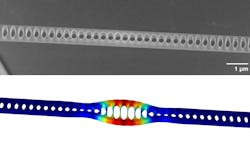In 2014, after a decade of development, the National Institute of Standards and Technology (NIST) presented the world with its most accurate clock known to science. The atomic clock measures the vibrations of cesium atoms to give our automatic time-telling gadgets, such as cell phones, a precise standard for setting the time.
Today, at an American Physical Society meeting in Baltimore, Md., the organization presented a system that precisely measures the vibrations of silicon-nitride molecules in response to changes in temperature, ranging from cryogenic to room temperature. The effort may lead to high-accuracy temperature readings in extremely sensitive lab applications and industry procedures.
The method employs a beam of silicon nitride with small reflective cavities. The scientists directed a laser through a thin crystal beam, and measure the changes in reflected wavelength, which they could directly relate to the picometer-scale thermal vibrations.
But what makes the method so dependable is the scientists' ability to calibrate the thermal vibrations to fluctuations in electron spin, which remain constant independent of temperature. Since both vibrations are measured using the same laser, any measurements that indicate changes in quantum vibrations would also indicate an error in the readings for thermal vibration.
|
Even at temperatures near absolute Kelvin, where atoms have insignificant thermal vibration, the uncertainty of an electron's position in its quantum state causes very small vibrations. A simple recap of the phenomena is provided in a video from my favorite YouTube channel, Sixty Sigma. |
About the Author
Leah Scully
Associate Content Producer
Leah Scully is a graduate of The College of New Jersey. She has a BS degree in Biomedical Engineering with a mechanical specialization. Leah is responsible for Machine Design’s news items that cover industry trends, research, and applied science and engineering, along with product galleries. Visit her on Facebook, or view her profile on LinkedIn.
